The global aircraft passenger exit path lighting market size was valued at $0.6 billion in 2022, and is projected to reach $1.1 billion by 2032, growing at a CAGR of 6.8% from 2023 to 2032.
Factors such as surge in air travel, technological advancements, rise in adoption of LED technology drive the growth of the aircraft passenger exit path lighting market across the globe. However, cost constraints and integration challenges act as barriers for the growth of the market Furthermore, rise in emphasis on passenger safety and the need for efficient emergency preparedness create ample opportunities for the growth of the market during the forecast period.
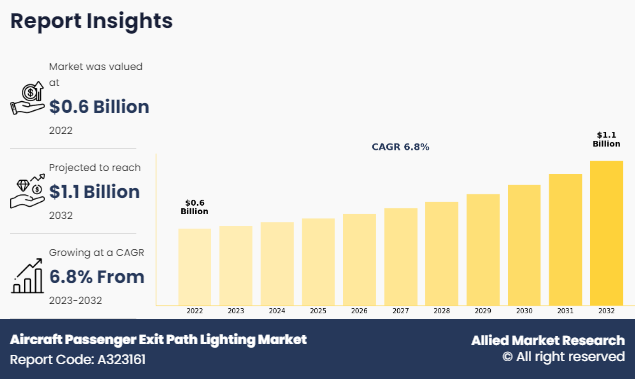
Key Takeaways
- On the basis of light source, LED segment held the largest share in the aircraft passenger exit path lighting market in 2022.
- By aircraft type, the commercial aircraft segment held the largest share in the market in 2022.
- On the basis of lighting type, the floor proximity lighting segment held the largest market share in 2022.
- On the basis of region, North America held the largest market share in 2022.
The aircraft passenger exit path lighting market refers to the sector involved in providing lighting solutions for the safe evacuation of passengers during emergencies in an aircraft. This includes illuminated pathways leading to emergency exits, floor proximity lighting, and other related systems designed to guide passengers to safety during low visibility conditions such as smoke or darkness.
For instance, in June 2023, LEDtronics announced the launch of its new LED passenger exit path lighting system for general aviation aircraft. The system is designed to be more affordable and easier to install than traditional lighting solutions.
Aircraft passenger exit path lighting refers to the specialized illumination infrastructure installed within the interior of an aircraft to facilitate the safe and efficient evacuation of passengers during emergency scenarios, particularly in conditions of compromised visibility such as darkness or smoke. This system comprises strategically positioned lights along the cabin aisle and in proximity to emergency exits, serving to describe clear and unambiguous pathways for passengers to navigate toward designated exit points.
The primary objectives of aircraft passenger exit path lighting market size include guiding passengers toward exits, ensuring the visibility of exit signs & pathway lighting even in adverse conditions, enhancing overall safety by providing clear visual cues to passengers & crew, and complying with regulatory standards established by aviation authorities pertaining to emergency lighting and evacuation procedures. Employing advanced technologies such as Light Emitting Diodes (LEDs), these lighting systems are engineered for robustness, reliability, and seamless integration with the aircraft's broader emergency systems, thereby playing a pivotal role in safeguarding lives and mitigating risks during critical moments of aircraft operations.
Furthermore, major market players have undertaken various strategies to increase the competition and offer enhanced services to their customers. For instance, in May 2023, Luminator Technology Group launched its new LED passenger exit path lighting system for commercial aircraft. The system is designed to be more energy-efficient and durable than traditional lighting solutions.
In addition, in April 2023, Honeywell International announced the expansion of its passenger exit path lighting product portfolio. The company added new LED and fluorescent lighting solutions to its lineup.For instance, in March 2023, Flight Safety International received FAA approval for its new LED passenger exit path lighting system for general aviation aircraft. The system is designed to meet the latest FAA safety standards.
Segment Review
The aircraft passenger exit path lighting market is segmented on the basis of light source, aircraft type, lighting type, and region. By light source, it is divided into LED, fluorescent, and incandescent. By aircraft type, the market is classified into commercial aircraft, general aircraft, and others. By lighting type, it is categorized into floor proximity lighting and emergency exit signs. By region, the market is analyzed across North America, Europe, Asia-Pacific, and Latin America and Middle East.
By Light Type
On the basis of lighting type, the floor proximity lighting segment attained the highest market share in 2022 in the aircraft passenger exit path lighting market. This is attributed to the fact that floor proximity lighting is highly effective in low-light or reduced visibility conditions, such as during nighttime flights or in the event of smoke or fire within the cabin. By illuminating the floor along designated escape paths, these lighting systems provide clear visual guidance to passengers, enabling them to locate and navigate toward emergency exits quickly and safely.
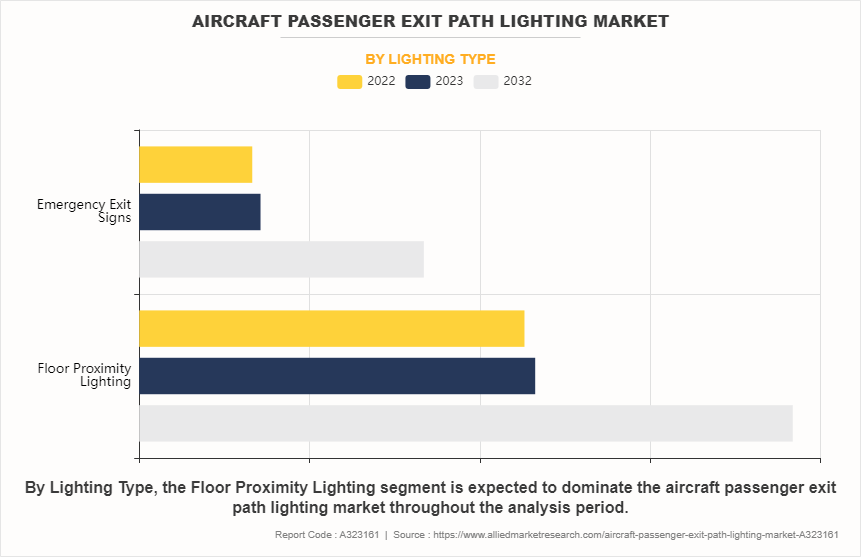
By Light Source
On the basis of light source, LED segment attained the highest market share in 2022 in the aircraft passenger exit path lighting market. This is attributed to the fact that LEDs are highly energy-efficient compared to traditional lighting sources such as incandescent or fluorescent bulbs. They consume significantly less power while providing the same or higher levels of illumination. This energy efficiency is particularly important in aircraft, where minimizing power consumption helps improve fuel efficiency and reduce operating costs.
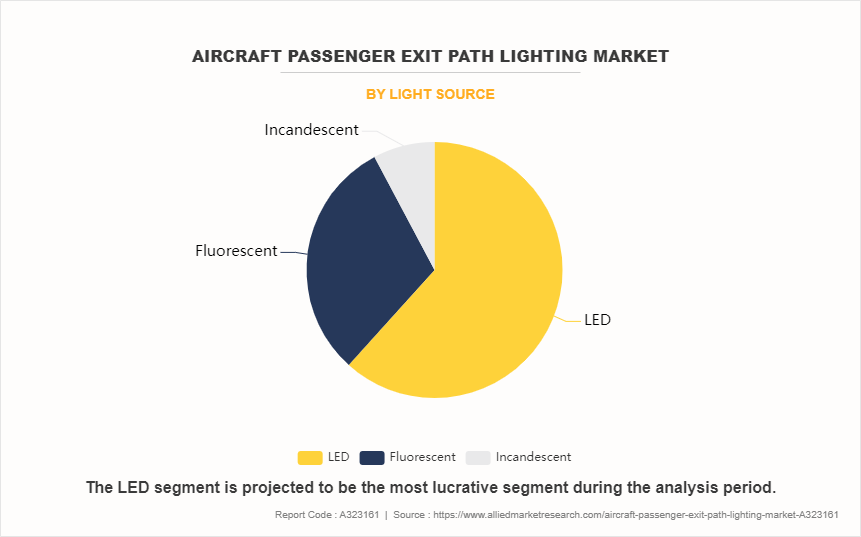
By Aircraft Type
On the basis of aircraft type, the commercial aircraft segment attained the highest market share in 2022 in the aircraft passenger exit path lighting market. This is attributed to the fact that the commercial aircraft are subject to strict regulatory standards set forth by aviation authorities such as the Federal Aviation Administration (FAA) in the U.S. and the European Union Aviation Safety Agency (EASA). These regulations mandate the installation of exit path lighting systems to guide passengers to emergency exits in the event of an evacuation. Compliance with these regulations drives the demand for exit path lighting solutions in commercial aircraft.
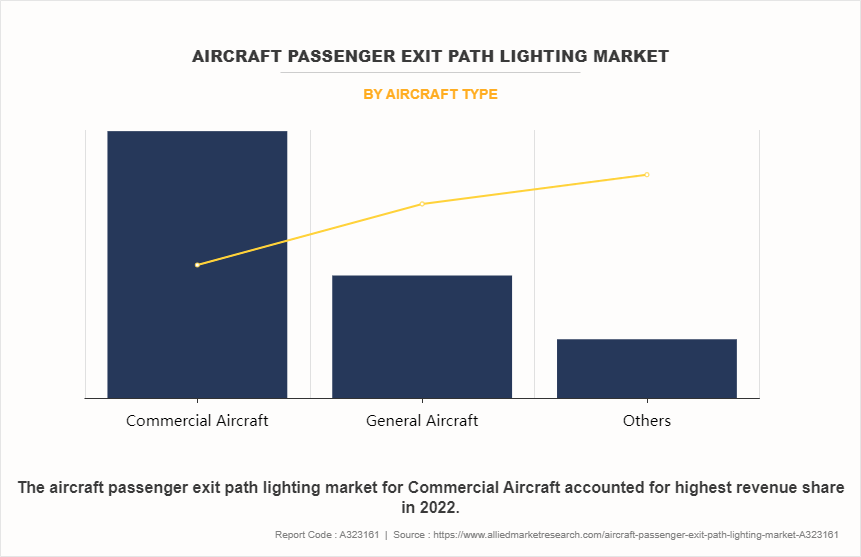
By Region
On the basis of region, the North America attained the highest market share in 2022 in the aircraft passenger exit path lighting market. This is attributed to the fact that North America, particularly the U.S., is a hub for technological innovation in the aerospace industry. Companies based in this region often pioneer advancements in aircraft lighting technologies, including those related to exit path lighting. This innovation leadership can drive market growth and adoption of new lighting solutions.
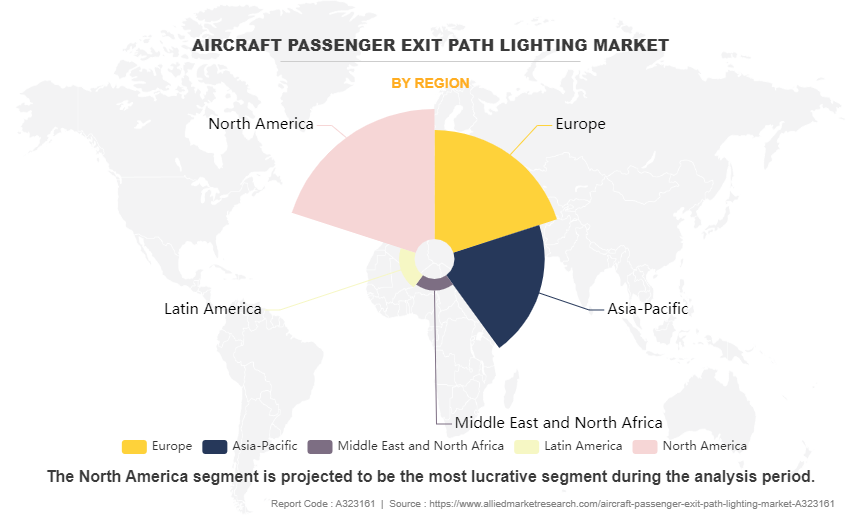
Competitive Analysis
Some of the major companies that operate in the global aircraft passenger exit path lighting market are Astronics Corporation, Collins Aerospace, Luminator Technology Group, LEDtronics, STG Aerospace, Bruce Aerospace, Diehl Stiftung & Co., Cobalt Aerospace Group Limited, Lufthansa Technik, and SKYbrary Aviation Safety.
Rise in the Demand of Air Travel
As air travel demand grows, airlines often increase the utilization of their aircraft to meet passenger needs. This means more flights per day and longer flight hours, leading to a higher likelihood of emergency situations occurring where exit path lighting becomes critical for passenger safety during evacuation procedures. To accommodate rise in passenger numbers, airlines frequently expand their fleets by acquiring new aircraft or retrofitting existing ones. Each aircraft added to the fleet requires compliant exit path lighting systems to ensure regulatory compliance and passenger safety standards.
Air travel growth often leads to the opening of new airports and the introduction of new routes to meet demand. These expansions increase the number of aircraft in operation and the complexity of air traffic, heightening the importance of reliable exit path lighting systems to facilitate safe evacuations during emergencies, especially in unfamiliar environments. With increased air travel, regulatory bodies such as the Federal Aviation Administration (FAA) in the U.S. and the European Union Aviation Safety Agency (EASA) in Europe are expected to introduce or update regulations to enhance aviation safety standards. Compliance with these regulations drives the demand for advanced exit path lighting systems that meet the latest safety requirements. Therefore, air travel growth has increased the demand in the aircraft passenger exit path lighting market share.
Technological Advancements
Exit path lighting systems have become more dependable and efficient as a result of advancements in lighting technology, particularly the widespread use of light emitting diodes (LEDs). LED lighting offers longer lifespans, lower power consumption, and greater durability compared to traditional lighting technologies, making them attractive options for aircraft operators seeking to upgrade their lighting systems. Furthermore, technological advancements enable greater integration of exit path lighting systems with other aircraft systems, such as the cabin management system or the flight control system. Integrated lighting systems be controlled more efficiently and provide additional functionalities, such as adaptive lighting levels based on ambient conditions or real-time monitoring of system health.
Newer exit path lighting systems incorporate automation and smart features to enhance functionality and ease of use. For example, automated self-testing and diagnostics help identify and address issues with the lighting system proactively, reducing maintenance downtime and improving overall reliability. In addition, smart lighting control systems adjust lighting levels dynamically based on factors such as passenger occupancy or emergency conditions. Therefore, technological advancements drive the growth of the aircraft passenger exit path lighting market trends.
Rise in Adoption of LED Technology
LED lighting is known for its energy efficiency, consuming significantly less power compared to traditional lighting sources such as incandescent or fluorescent bulbs. As airlines and aircraft operators seek to reduce operational costs and improve fuel efficiency, the adoption of LED technology for exit path lighting helps achieve these goals by minimizing power consumption without compromising illumination quality. Furthermore, LEDs have a much longer lifespan than traditional lighting sources, lasting tens of thousands of hours compared to the relatively short lifespan of incandescent or fluorescent bulbs. This longevity reduces the frequency of maintenance and replacement cycles for exit path lighting systems, resulting in lower maintenance costs and decreased downtime for aircraft.
LED lighting fixtures are inherently more durable and resistant to shock and vibration compared to traditional bulbs, making them well-suited for use in aircraft environments where mechanical stresses are common during flight operations. This durability ensures that LED-based exit path lighting systems remain operational and reliable even under challenging conditions. Therefore, the rise in adoption of LED technology has increased the demand for aircraft passenger exit path lighting industry.
Cost Constraints
The upfront cost of purchasing and installing advanced exit path lighting systems is substantial for airlines and aircraft operators, particularly for larger fleets or when retrofitting older aircraft models. The high initial investment required deters some operators from upgrading to newer, more advanced lighting solutions, especially if they perceive the benefits as not justifying the expense. In addition, to the initial capital outlay, there are ongoing operational expenses associated with maintaining and servicing exit path lighting systems. This includes costs related to routine inspections, maintenance, and potential repairs or replacements over the lifespan of the lighting equipment. For airlines operating on thin profit margins, these ongoing expenses add up and further strain budgets.
The aviation industry is highly competitive, with airlines constantly seeking ways to reduce costs and improve efficiency. As a result, there is pressure to keep prices low, including for safety equipment such as exit path lighting systems. This limits the ability of manufacturers and suppliers to command premium prices for their products, potentially impacting profitability and investment in innovation. Therefore, cost constraints are hampering the growth of the aircraft passenger exit path lighting industry.
Integration Challenges
Adapting newer exit path lighting systems into existing aircraft fleets be challenging due to compatibility issues with older aircraft models or pre-existing cabin configurations. Integrating modern lighting systems with legacy aircraft systems and wiring requires extensive modifications or adaptations, increasing complexity and costs for operators. Furthermore, any modifications or upgrades to aircraft systems, including exit path lighting, must meet stringent certification and regulatory requirements set by aviation authorities such as the Federal Aviation Administration (FAA) in the U.S. or the European Union Aviation Safety Agency (EASA) in Europe. Ensuring compliance with these regulations adds time and resources to the integration process, potentially delaying implementation.
Exit path lighting systems must seamlessly integrate with other aircraft systems, including emergency power systems, cabin management systems, and flight control systems, to ensure proper operation during emergencies. Ensuring interoperability and coordination between different systems is technically challenging, requiring careful design and testing to achieve reliable performance. Therefore, integration challenges hamper the growth of the aircraft passenger exit path lighting market.
Rise in Emphasis on Passenger Safety and the Need for Efficient Emergency Preparedness
With an increased focus on passenger safety, airlines and aircraft operators are increasingly investing in advanced safety equipment, including exit path lighting systems. These systems play a crucial role in guiding passengers to emergency exits during low visibility conditions, such as smoke or darkness, ensuring orderly evacuations and minimizing the risk of injury or loss of life. Furthermore, aviation regulatory authorities worldwide, such as the FAA in the U.S. and EASA in Europe, continue to strengthen safety regulations and standards for commercial and general aviation. Compliance with these regulations requires aircraft operators to equip their fleets with compliant exit path lighting systems, driving demand for modern and efficient lighting solutions.
As the aviation industry faces various challenges, including natural disasters, terrorist threats, and health crises, there is a growing recognition of the importance of effective emergency preparedness. Advanced exit path lighting systems contribute to this preparedness by providing clear guidance to passengers and crew during evacuations, helping to mitigate risks and ensure a swift and orderly response to emergencies. The emerging market for small satellite offers ample opportunities for aircraft passenger exit path lighting market.
Impact of Russia-Ukraine War on Industry
The Russia-Ukraine war can potentially impact various aspects of aviation, including the availability of aircraft components and maintenance services. However, it's essential to understand that aircraft passenger exit path lighting is a critical safety feature mandated by aviation authorities worldwide. Therefore, airlines and aircraft manufacturers will likely prioritize ensuring the functionality and compliance of these systems despite any geopolitical developments Companies sourcing materials or components from these regions face delays or shortages, impacting their ability to meet demand.
Geopolitical tensions and armed conflict lead to market volatility and uncertainty, affecting investor confidence and business sentiment in the aerospace industry. Companies operating in the aircraft passenger exit path lighting market experience fluctuations in demand, pricing, and investment decisions as a result of geopolitical instability.
The Ukraine-Russia war have prompted regulatory changes or heightened security measures in the aviation sector, potentially impacting safety standards, certification processes, or export controls related to aircraft passenger exit path lighting systems. Companies need to adapt to new regulatory requirements or compliance measures, affecting their operations and market dynamics. The conflict could impact air travel demand, infrastructure development, and investment priorities in the region, potentially influencing the demand for Aircraft Passenger Exit Path Lighting systems. Economic disruptions or shifts in aviation market dynamics in Ukraine, Russia, or neighboring countries have current effects on the broader aerospace industry.
Recent Developments in the Aircraft Passenger Exit Path Lighting Industry
- In June 2023, LEDtronics announced the launch of its new LED passenger exit path lighting system for general aviation aircraft. The system is designed to be more affordable and easier to install than traditional lighting solutions.
- In May 2023, Luminator Technology Group launched its new LED passenger exit path lighting system for commercial aircraft. The system is designed to be more energy-efficient and durable than traditional lighting solutions.
- In April 2023, Honeywell International announced the expansion of its passenger exit path lighting product portfolio. The company added new LED and fluorescent lighting solutions to its lineup.
- In March 2023, Flight Safety International received FAA approval for its new LED passenger exit path lighting system for general aviation aircraft. The system is designed to meet the latest FAA safety standards.
- In February 2023, Astronics Corporation announced the launch of its new LED passenger exit path lighting system for commercial aircraft. The system is designed to provide enhanced visibility and safety for passengers during an emergency evacuation.
Key Benefits for Stakeholders
- This study presents the analytical depiction of the global aircraft passenger exit path lighting market analysis along with the current trends and future estimations to depict imminent investment pockets.
- The overall market opportunity is determined by understanding profitable trends to gain a stronger foothold.
- The report presents information related to the key drivers, restraints, and opportunities of the global market with a detailed impact analysis.
- The current market is quantitatively analyzed from 2022 to 2032 to benchmark financial competency.
- Porter five forces analysis illustrates the potency of the buyers and suppliers in the industry.
Aircraft Passenger Exit Path Lighting Market Report Highlights
| Aspects | Details |
| Market Size By 2032 | USD 1.1 billion |
| Growth Rate | CAGR of 6.8% |
| Forecast period | 2022 - 2032 |
| Report Pages | 283 |
| By Lighting Type |
|
| By Light Source |
|
| By Aircraft Type |
|
| By Region |
|
| Key Market Players | Diehl Stiftung & Co. KG, Astronics Corporation, Luminator Technology Group, LLC, LEDTRONICS, Inc., Lufthansa Technik, Cobalt Aerospace Group Limited, Collins Aerospace, Bruce Aerospace, SKYbrary Aviation Safety, STG Aerospace Ltd. |
Astronics Corporation, Collins Aerospace, Luminator Technology Group, LEDtronics, STG Aerospace, Bruce Aerospace, Diehl Stiftung & Co., Cobalt Aerospace Group Limited, Lufthansa Technik, and SKYbrary Aviation Safety
$1.1 billion by 2032 is the estimated industry size of Aircraft Passenger Exit Path Lighting
North America is the largest regional market for Aircraft Passenger Exit Path Lighting
LED is the leading application of Aircraft Passenger Exit Path Lighting Market
Adoption of LED are the upcoming trends of Aircraft Passenger Exit Path Lighting Market in the world
Loading Table Of Content...
Loading Research Methodology...



